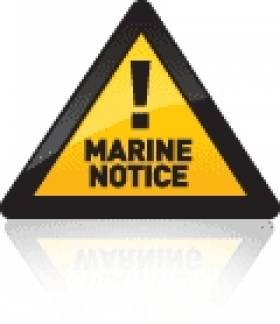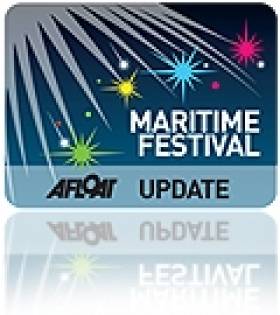Displaying items by tag: Weather
#LoughNeagh - The Belfast Telegraph has posted an incredible photo of a funnel cloud that appeared over Lough Neagh last week.
Barry McGuigan, a fisherman working on the largest lake in the island of Ireland, captured the stunning image of the unusual cloud formation - often the precursor to a tornado - as it hovered over the water close to another fishing vessel.
"It was like a twister but it stayed in one place for five to 10 minutes and then it just fizzled out," he said.
It's now believed to be the most photographed and videoed weather phenomenon in Northern Ireland, with this video posted to YouTube by John McCorry just one example.
Meanwhile, the Belfast Telegraph also reports that the aristocratic owner of Lough Neagh has vowed to work with the NI Legislative Assembly on its strategic management.
The 12th and present Earl of Shaftesbury, philanthropist and endurance athlete Nick Ashley-Cooper, said he welcomed the conclusion of a long-delayed report into the future of the lough and "wholeheartedly" agrees with its findings.
It comes some months after fears that the report by a special working group would remain shelved at Stormont, and its findings never made public.
"The report indicates clearly that the estate's ownership of the bed and soil is not a barrier to any potential development and that there is no compelling argument in favour of public ownership," said Lord Shaftesbury.
The Belfast Telegraph has more on the story HERE.
Shipping Forecast Fails To Air For First Time In Decades
#Weather - The BBC's Shipping Forecast failed to air as scheduled yesterday morning for the first time in 90 years.
The Guardian reports that the mishap was the result of a technical glitch whereby BBC Radio 4's overnight switchover to the World Service did not switch back as planned in time for the 5.20am weather bulletin for the UK and Ireland's shipping areas.
Many listeners were quick to voice their displease on social media, though the forecast did eventually go out at 6.40am, an hour and 20 minutes late.
However, the glitch may be seen as a bad omen for some after warnings late last year over a transmitter shutdown now ongoing that may affect reception of the Shipping Forecast in the Irish Sea.
Dublin Bay Buoy Is Live-Tweeting The Weather
#DublinBay - Twitter users can now track live weather updates from a buoy in the middle of Dublin Bay.
The @DublinBayBuoy account is tweeting at regular intervals with the average wind speed, gust speed and wind direction on the bay, as well as the current wave height and water temperature.
And it's all been made possible thanks to an array of sensors installed on the buoy by the Commissioners of Irish Lights to record live meteorological ocean data.
The Twitter bot should come especially handy at this weekend's Battle for the Bay among some the world's top kitesurfing talent.
More Treasures Unearthed In Atlantic Storm Aftermath
#CoastalNotes - The extreme Atlantic storms of the first weeks of this year have proved a boon for archaeologists and other heritage enthusiasts on the western coastline, from the exposing of the wreck of a century-old schooner to the remains of Neolithic graves and the traces of an ancient 'drowned' forest.
And as The Irish Times reports, the aftermath of that serve weather is continuing to reveal more artefacts from Ireland's past, such as a forgotten harbour from the medieval period, early Christian burial sites and tools from the Mesolitic era.
Meanwhile, the drowned forest discovered on the northern shore of Galway Bay is providing evidence of what can happen when our planet experiences climate change, according to a local geology academic.
“That forest drowned because of weather,” says Prof Michael Williams of NUI Galway. “It was flourishing 5,000 years ago and then the climate in the north Atlantic changed. It became cooler and wetter, and the sea level began to rise."
Even so, Prof Williams doesn't deny the effects of the human footprint on climate change today, but warns that regardless of human action, future generations must prepare for rising seas over the next tens of thousands of years.
The Irish Times has more on the story HERE.
Marine Notice: Marine Meteorological Monitoring Survey 2014
#MarineNotice - Marine Notice No 29 of 2014 calls on all ship managers, shipmasters, sailors, operators of fixed platforms and operators of non-SOLAS vessels to participate in the 2014 Marine Meteorological Monitoring Survey, which is available HERE.
The World Meteorological Organization (WMO) conducts the Marine Meteorological Monitoring Survey (MMMS) on a regular basis.
This is a tool to improve the level of meteorological support co-ordinated by the Joint WMO-IOC Technical Commission for Oceanography and Marine Meteorology (JCOMM), providing invaluable information to understand and reflect the needs and requirements of all marine communities in order to improve Marine Meteorological Information Services, as part of the Global Maritime Distress and Safety System (GMDSS).
The survey will continue until 30 June 2014. Any questions or enquiries should be made directly to the WMO Marine Meteorology and Oceanography Programme by email to [email protected] and not to the Department of Transport, Tourism and Sport.
Irish Weather Symposium for NUI Galway
#nuigalway – A recently-published report by the UN's Intergovernmental Panel on Climate Change (IPCC) makes dire predictions about the adverse effects and impacts of climate change. The Irish Met Society and NUI Galway have joined up to organise a Symposium on ongoing work in Ireland in researching and monitoring of our atmosphere. The Symposium, which will take place in the Martin Ryan Annex Lecture Theatre in NUI Galway, includes presentations on atmospheric monitoring and research activities of national bodies such as the Environmental Protection Agency, Met Éireann and the Marine Institute. It will be held on Saturday next, 5 April from 10.45am and will be followed on Sunday by a trip to the NUI Galway Atmospheric Research Station at Mace Head in Connemara. All details are available on the Irish Met Society website at www.irishmetsociety.org.
The Symposium should be especially relevant to bodies such as local authorities, farming and other organisations where the weather can have an impact on their work. The aim of the Symposium is to encourage more synergy between the various agencies that are active in atmospheric monitoring and to promote greater use of the data collected. It will provide an opportunity for members of the public and individuals directly involved in Atmospheric Research and Monitoring to inform themselves on current activities in those areas.
A highlight of the day features Dinah Molloy, a researcher with the Scott Polar Research Institute in Cambridge. She uses the weather records kept by captains of whaling ships in the 1700s and 1800s to describe the climate at that time. This is of interest in the light of this week's IPCC report, which refers to how recent weather events such as melting ice caps, more intense rains, more frequent storms and heat waves were brought about by climate change.
A presentation on the work of the European Centre for Medium Range Weather Forecasts (ECMWF) in monitoring air pollutants and their effect on the weather brings an international flavour to the event. Other presentations highlight the work of scientists in NUI Galway at an international level, through their work at Mace Head since 1958. This work is led by Professor Colin O'Dowd, a recent recipient of the Royal Irish Academy Gold Medal for outstanding contribution to the Environment and Geosciences. Aspects of their work will include research on the impact of aerosol particles on the sunlight reaching the earth.
Other organisations that will be describing their work are Met Éireann, the Radiological Protection Institute of Ireland, the Marine Institute and the Environmental Protection Agency. The monitoring of radiation levels in the atmosphere, in particular in an emergency situation, is the focus of one presentation. Other presentations describe how data on the atmosphere are gathered at sea using buoys and on land through a network of observing stations. Improving the accuracy of air quality forecasting is addressed in a presentation by the Environmental Protection Agency.
For background and further information contact Paul Halton, President of the Irish Met Society at [email protected]
Get Afloat For Paddy's Weekend!
#PaddysDay - After months of storm-force winds, relentless rain and flooding, and often freezing conditions, there's finally some light on the horizon - as Met Éireann says the weather will be mostly dry and settled for the coming weeks.
As TheJournal.ie reports, a persistent high-pressure system is bringing us sunshine every day this week as we head towards St Patrick's Day next Monday.
That's great news for those planning to attend St Patrick's Festival events around Ireland this weekend - not least Ireland's many boaters, who will surely be itching to get their vessels out of winter storage and back on the water to enjoy the late spring and summer season.
Landlubbers in the capital, meanwhile, can also make the most of the fine weather by taking part in the annual Harbour 2 Harbour walk raising funds for mental health charity Aware.
As always, the 25km route runs between Howth and Dun Laoghaire, with participants free to walk either direction around Dublin Bay. For details on how to take part and get sponsorship see the Aware website HERE.
And while in Dun Laoghaire, why not pay a visit to the new exhibition of sailing paintings at the National Maritime Museum of Ireland.
Of Sail and Ships, which has its official launch this Wednesday 12 March, displays some of the museum's collection of some 400 paintings, charts and other images, along with winners of the Marine Institute's recent children's art competition.
Cork Head of the River Stands Alone as Lagan Event Falls
#ROWING: Lagan Scullers’ Head of the River, scheduled for Saturday in Belfast, has been cancelled. “The forecast was bad and getting worse,” said race director Gordon Reid this afternoon. The weather system could have made the course dangerous. Cork Head, however, is set to go ahead at the Marina on Saturday, with an entry of 280 crews. The high water levels on the Corrib have led to the early cancellation of Galway Head, which was set for St Patrick’s weekend.
Erne Head Cancelled As Weather Forecast Changes
ROWING: The Erne Head of the River has been cancelled. A radical change in the forecast, with high winds predicted, convinced the organisers that there was a chance that some boats could get into difficulty. The event set for Saturday, was set to be to be the first domestic event of the rowing season – on March 1st. All the other heads of the river have cancelled because of weather-created difficulties.
Rowing Hit Again as Cork Head Falls to Weather
#ROWING: Cork Head of the River, which was scheduled for the Marina in Cork tomorrow (Friday) has been called off. The honorary secretary of the organising committee, Susan Dunlea, informed interested parties today of the decision, stating: "It is with regret that I have to inform you that Cork HOR scheduled to take place tomorrow, Saturday 15th February, has to be cancelled due to the weather forecast. Apologies for any inconvenience caused."
Irish rowing has had no competitive event this year so far. Six heads of the river have been called off: Kerry, Sligo, St Michael's, Shannon, Lagan and now Cork. St Michael's originally rescheduled for next Saturday, February 22nd, but last night abandoned this plan as well.





































































